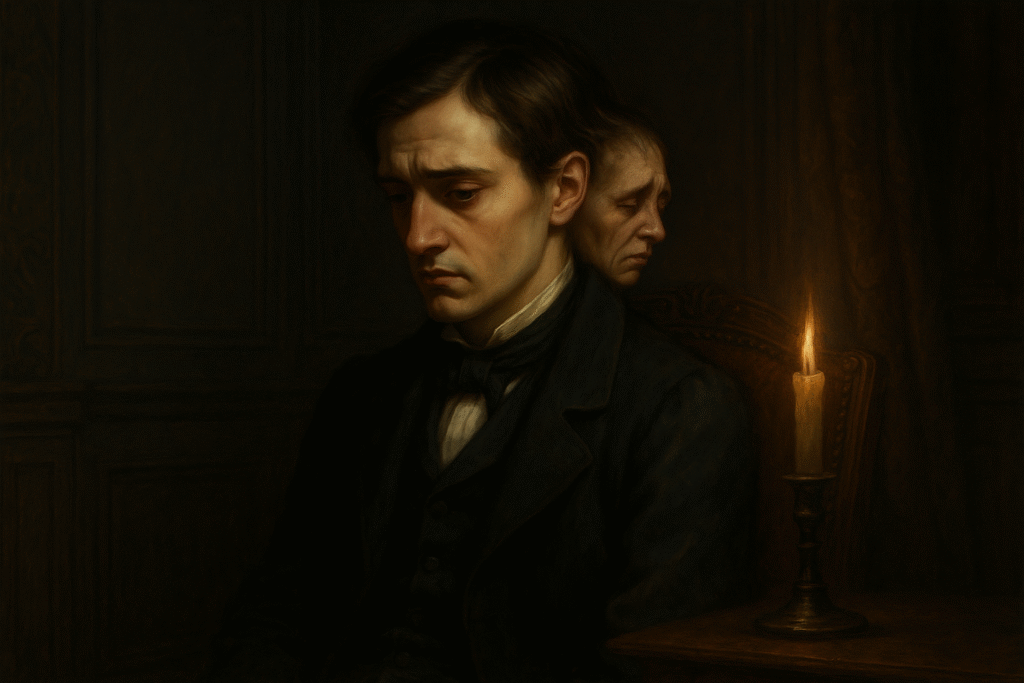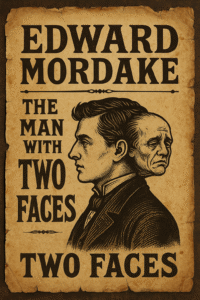The Face That Shouldn’t Speak
Some time in 19th-century England, a young man by the name of Edward Mordake was born into an aristocratic family. He was known to be handsome, intelligent, gentle, musically gifted, and deeply melancholic—and by all means, quite an eligible bachelor. But unfortunately, he was haunted by a terrible deformity. Edward was born with a second face on the back of his head.

There are cases throughout medical history of such things occurring. It is believed that Edward suffered from craniopagus parasiticus, a rare case of a parasitic twin that forms a face on the host’s body. Edward would hide this deformity under his hair, and by all other accounts, was a normal young nobleman in his twenties.
But Edward claimed that this face would whisper to him in the night—something not typically seen with this condition. This second face was reportedly smaller than his real one, with features distorted like wax melting in candlelight. It could not eat or speak aloud, but it could smile, frown, and weep. Most disturbingly, it was said to be conscious, and at night, it whispered unspeakable things to Edward: words of damnation, madness, and temptation.
Due to his condition, Edward became a recluse. He was said to have been driven to near-insanity by the second face, and he begged physicians to remove it or at least help him cope with it. He said it whispered to him at night such unspeakable things, but the doctors dismissed it as delusion or hallucination.
He was reported to have told them:
“It never sleeps, but talks to me forever of such things as they only speak of in hell.”
He also supposedly wrote:
“No imagination can conceive the dreadful temptations it sets before me… I am kept from sleep every night by its hateful whispers.”
Despite his pleading, Edward wasn’t granted relief by the physicians. Eventually, in desperation, Edward took his own life, blaming the voices and requesting in his note that the face be separated from him and destroyed:
“Lest it continues its dreadful whisperings in my grave.”
Did Edward Mordake Actually Exist?
Nothing much is known about the young English nobleman—because it seems that he didn’t actually exist, despite his tale being cemented in popular culture and even seeing a recent resurgence thanks to his reference in the television show American Horror Story: Freak Show, where he was portrayed as a spectral entity that claimed souls.
There is no real evidence that the man ever existed.
The first and only reference to Edward Mordake is an 1895 article published in The Boston Post, attributed to a writer named Charles Lotin Hildreth. The piece described bizarre human anomalies, claiming they came from the “Royal Scientific Society”—a name with no basis in real institutions. It’s easy to dismiss the account as nothing more than a 19th-century urban legend or the Victorian equivalent of a modern creepypasta.
Modern researchers believe Hildreth invented the entire account for entertainment, likely drawing on the Victorian fascination with freak shows and anatomical oddities. Yet because of its vivid detail and psychological horror, Edward’s story took on a life of its own.
The Sideshow Inspirations
It’s easy to see where Hildreth may have drawn inspiration. There were real people in that era living and working as sideshow performers with conditions similar to those described. Jean Libbera, who went by the name The Double-Bodied Man, had a parasitic twin he called Jacques and made his living on the Victorian sideshow circuit. There was also Myrtle Corbin, a woman from Texas born in the 1800s who famously had an underdeveloped second set of legs protruding from her body—remnants of a parasitic twin.

The closest real-world account that can be found is the story of the Two-Headed Boy of Bengal. The boy, reportedly born in 1790 in India, had a parasitic twin that gave him a second head. Though hard medical evidence is scarce, descriptions say:
“The term ‘Two-Headed’ may be a bit misleading, as rather than two heads side by side, the boy actually had one head atop the other. Both heads were appropriately sized. The second head sat atop the main head inverted and simply ended in a neck-like stump. The second head seemed to, at times, function independently from the main head. When the boy cried or smiled, the features of the second head did not always match. Yet, when the main head was fed, the second head would produce saliva. Furthermore, if the second head was presented with a breast to suckle, it would attempt to do so. While the main head was well-formed, the secondary head possessed some irregularities. The eyes and ears were underdeveloped. The tongue was small and the jaw malformed, but both were capable of motion. When the boy slept, the secondary head would often be observed alert and awake—eyes darting about.”
One can’t help but draw comparisons between this story and that of Edward Mordake. The Bengal boy was reported to have lived before the Mordake tale was written, and it’s not hard to imagine tales of this child reaching England and sparking the imagination of a horror writer. In that time period, horror stories often explored torment and justice—Edgar Allan Poe, for example, was famous for The Tell-Tale Heart, a story of a murderer driven mad by the sound of his victim’s heartbeat under the floorboards. But what sets Edward’s story apart—and perhaps what continues to capture imaginations—is that Edward was an innocent.
He wasn’t a villain or a monster, just a man afflicted by a cruel twist of fate. A victim of his own anatomy and the era’s inability to help him. And even though he may be fictional, we feel empathy for his plight.
A Living Legend
In conclusion, two possibilities emerge:
- Edward is a fictional character conjured by a clever writer whose work was so effective, it blurred the line between fact and legend.
- Or Edward may have been inspired by a real person—someone born with a deformity who lived in seclusion and whose story was transformed into gothic horror.
Fictional or not, Edward Mordake continues to live on in popular imagination. His is the tale of a man lying in bed, eyes clamped shut, hands pressed to his ears, rocking in desperation. Unable to escape the voice behind his own head. And in his final moments, he sits at his desk, trembling as he writes his last wish on paper:
That the thing behind him—never be allowed to speak again.
Sources & Further Reading
- Hildreth, Charles Lotin. “The Wonders of Modern Science.” The Boston Post, 1895. (Original article introducing Edward Mordake)
- Wikipedia contributors. “Edward Mordake.” Wikipedia, https://en.wikipedia.org/wiki/Edward_Mordake
- Nickell, Joe. “The Curse of the Devil’s Mark.” Skeptical Inquirer, 2013.
- Royal College of Surgeons – historical discussions on craniopagus parasiticus.
- Mütter Museum (Philadelphia) – medical specimens and cases of parasitic twins.
- History Collection – “The Two-Headed Boy of Bengal.”
- Anecdotal summary of the Bengal case – https://www.kickassfacts.com/the-two-headed-boy-of-bengal/
- American Horror Story: Freak Show – Season 4, FX Television.
- Smithsonian Magazine – “The Bizarre Lives of Sideshow Performers.”
